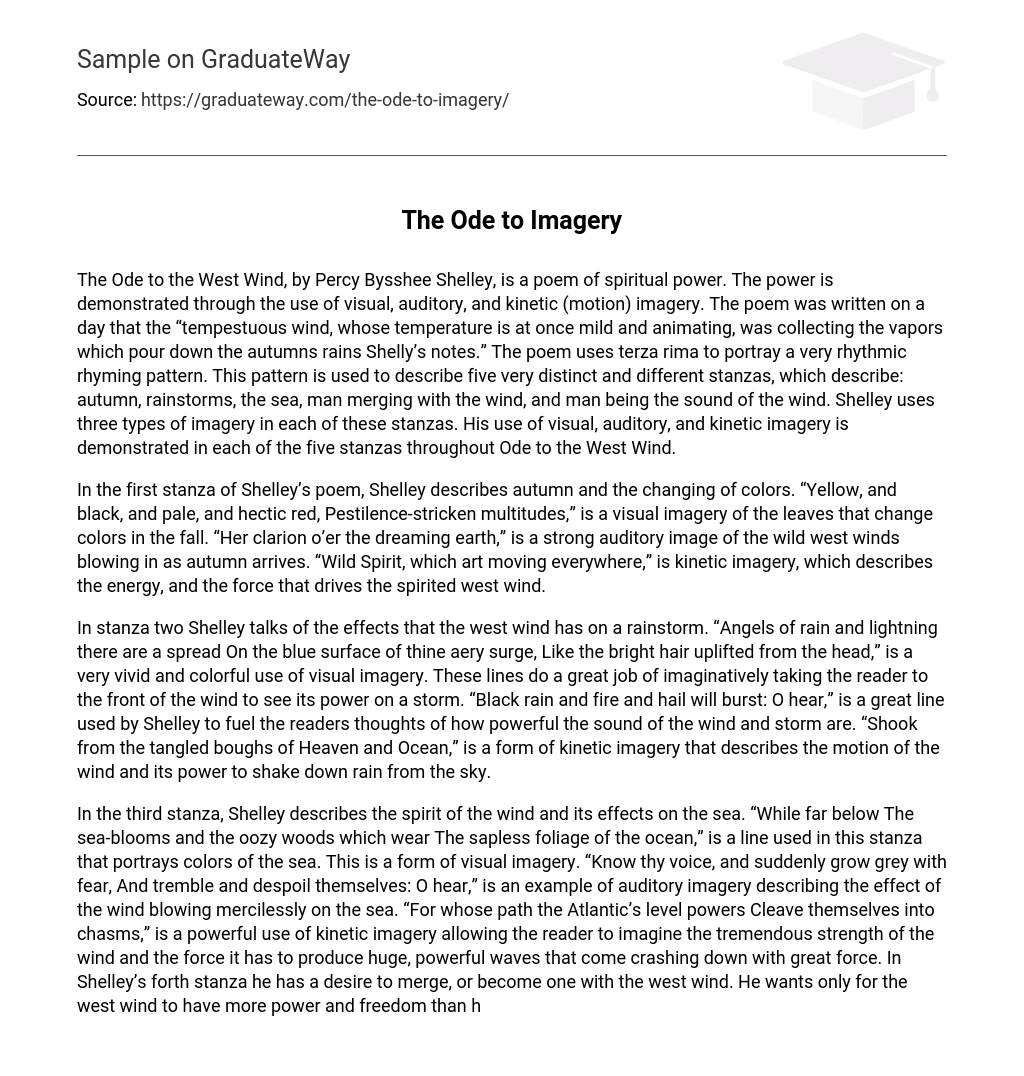The Ode to the West Wind, a poem by Percy Bysshee Shelley, showcases its spiritual power through visual, auditory, and kinetic imagery. Shelley wrote the poem on a day when the “tempestuous wind” was gathering the autumn rains. The poem employs terza rima, a rhyming pattern that adds rhythm. Each of the five stanzas focuses on a different subject: autumn, rainstorms, the sea, man merging with the wind, and man embodying the sound of the wind. Throughout Ode to the West Wind, Shelley skillfully employs visual, auditory, and kinetic imagery.
In the opening stanza of Shelley’s poem, he vividly depicts autumn and the transformation of colors. The phrase “Yellow, and black, and pale, and hectic red, Pestilence-stricken multitudes” serves as a striking visual representation of the changing foliage in fall. Furthermore, the line “Her clarion o’er the dreaming earth” presents a powerful auditory image portraying the arrival of autumn through the resounding call of the wild west winds. Additionally, the phrase “Wild Spirit, which art moving everywhere” captures the dynamic energy and commanding force embodied by the spirited west wind.
In the second stanza, Shelley vividly describes the effects of the west wind on a rainstorm. The lines “Angels of rain and lightning there are spread / On the blue surface of thine aery surge, / Like the bright hair uplifted from the head” use visual imagery to paint a colorful picture. These lines transport the reader to the front of the wind, allowing them to witness firsthand its power on a storm. The line “Black rain and fire and hail will burst: O hear” effectively conveys the intense sound and strength of both the wind and the storm. Additionally, the phrase “Shook from the tangled boughs of Heaven and Ocean” employs kinetic imagery to depict the wind’s motion and its ability to shake rain down from the sky.
In the third stanza, Shelley portrays the spirit of the wind and its impact on the sea through the line, “While far below The sea-blooms and the oozy woods which wear The sapless foliage of the ocean”. This line utilizes visual imagery to depict the colors of the sea. The auditory imagery in the line “Know thy voice, and suddenly grow grey with fear, And tremble and despoil themselves: O hear,” describes how the wind’s merciless blowing affects the sea. Additionally, the line “For whose path the Atlantic’s level powers Cleave themselves into chasms” effectively employs kinetic imagery to convey the immense strength of the wind and its ability to generate powerful waves that crash down with great force.
In the fourth stanza, Shelley expresses his desire to unite or merge with the west wind. He longs for the west wind to possess more power and freedom than himself. Through the phrase “If I were a dead leaf thou mightest bear, If I were a swift cloud to fly with thee,” he employs visual imagery to beautifully describe himself as an object that could travel freely with the west wind. In “A wave to pant beneath thy power,” Shelley incorporates auditory imagery to engage his readers’ sense of hearing and create a feeling of oneness with the wind. Furthermore, in “Oh! Lift me as a wave, a leaf, a cloud!”, Shelley utilizes kinetic imagery to express his desire to be lifted and carried by the wind like a wave, leaf, or cloud.The poet desires to rise above the hardships of life and merge with the mighty west wind, as expressed by the line “I fall upon the thorns of life!”
Shelley’s final stanza expresses his wish to become one with the wind, to embody the music and sounds that it creates while rustling through the trees. He uses visual imagery in the line “What if my leaves are falling like its own,” providing a picturesque image of autumn and the graceful descent of leaves. Immediately following, he invites the reader to envision “The tumult of thy mighty harmonies,” representing the sound of the wind as it rushes through the trees, detaching leaves and causing them to fall to the forest floor. Shelley further employs kinetic imagery in the line “Scatter, as from an unextinguished hearth Ashes and sparks,” vividly describing the forceful power with which the wind sweeps through the vast expanse of trees.
Throughout Ode to the West Wind, Shelley employs three types of imagery: visual, auditory, and kinetic. Visual imagery involves the portrayal of a thought through the depiction of an object; auditory imagery involves the thought of something conveyed through sound; and kinetic imagery involves the vision of something in motion or a powerful force. The poem’s use of imagery imbues it with a sense of vitality, bestowing upon the wind such potent abilities that the reader feels like a mere object in its path.
Bibliography: N/A





